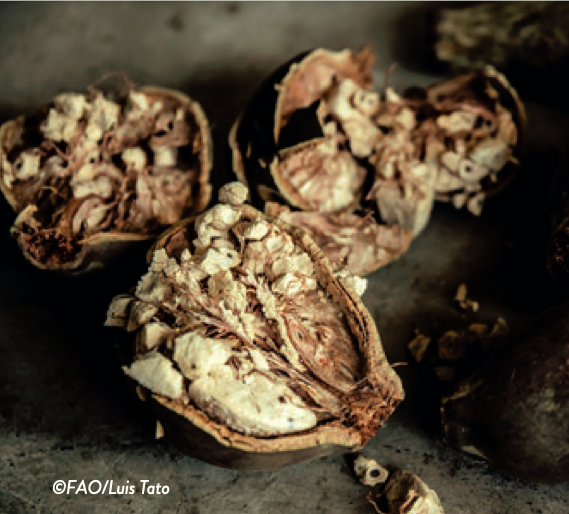
Fruits of Baobab- a tree native to the Africa savannah region- are eaten with milk or milk porridge or eaten as a snack.
Rome: Indigenous communities across Africa have used a number of locally adapted crops for millennia mainly for nutrition, medicinal and ornamental purposes. However, many of these crops, have been progressively substituted with imported genotypes favoured by industrial agriculture. Pervasive monoculture of the exotic crops and increasingly standardized diets have contributed in part to the utter denigration of the indigenous crops, earning them the appellation of “forgotten crops.”
Today, Africa is paradoxically reliant on imported food and home to a disproportionate share of the world’s hungry while at the same time boasting the potential to be a global breadbasket and food superpower. Part of realizing that potential depends on tapping the continent’s vast array of food crops, which too often have been pushed off-stage by global commodity foods produced elsewhere. These include traditional local mainstays such as Bambara groundnut and pigeons peas, superfoods such as fonio or baobab fruit, and naturalized vitamin-rich crops such as amaranth or taro.
Transforming food systems in Africa is imperative for the realization of the UN’s Sustainable Development Goals, which now have a delivery timeline of less than a decade.
A new ‘Compendium of Forgotten Foods in Africa‘ aims to move the needle by identifying so-called orphan foods that very often are “locally adapted and less fastidious than exotic cultivars” such as maize, rice or wheat.
At least 30,000 of the 350,000 known plant species on our planet are edible, but only 170 are cultivated for food on any significant scale. The contemporary global agrifood system depends on only a few crops that are cultivated on extensive monoculture. Today, just 12 plant species (and five types of animals) make up 75 per cent of the world’s food sources. Around 60 per cent of all the calories and proteins we obtain from plants come from just three crops: rice, maize and wheat.
Relying on so few plant species to feed the world is fraught with risks. Biotic threats, accentuated by climate change, such as the recent Fall Armyworm devastation of large swathes of maize fields across Africa, are a typical case in point. Similarly, the Panama Disease has decimated Cavendish bananas in over 100 countries worldwide; while the cassava mosaic virus nearly obliterated cassava production in many African countries.
Although breeding efforts have meant some gains in the fight against such invasive pests and devastating diseases, rotational cultivation of broad-based plant germplasm on crop fields is a time-tested preventive measure against biotic and abiotic threats.
In many cases, the “forgotten foods” exhibit adaptability and resilience to the local agro-climatic conditions and appeal to traditional farming systems that rely on farmer-preserved germplasm and regenerative agricultural principles. Increasingly, many actors are realizing that such undervalued crops have the power to combat hunger and malnutrition, respond to climate change, promote biodiversity, improve rural livelihoods, and support healthier and more secure food systems.
Thus, especially in the African context, reviving forgotten food crops is not turning back the clock on modern agriculture; rather it is recalibrating agriculture to ensure food and nutritional security sustainably and in perpetuity. Potentially, the mainstreaming of forgotten foods will promote biodiversity and minimize production risks associated with the current agrifood system.
Produced by the Food and Agriculture Organization of the United Nations (FAO) in partnership with the Forum for Agricultural Research in Africa (FARA), the compendium presents 100 examples of neglected local foods that have the potential to sustainably provide the much-needed dietary nutrients to various communities across Africa.
The 100 examples collated in the compendium, with imagery, agroecological suitability, agronomic requirements, and nutritional qualities, were selected after an initial canvassing of experts around Africa, whose specialities range from value-chain development to genetic improvement.
The so-called forgotten food crops are nutritious, resilient and adaptable to local dietary practices. They thus offer a viable pathway to ensuring adequate food intake and dietary diversity, maintaining soil health, and achieving climate resilience amongst African farming communities. Mainstreaming forgotten foods in the daily diets of African communities should therefore be a core component of any attempts at sustainable food system transformation in the region.
The compendium is a scoping study and a first step in what will be “an exhaustive identification and characterization of forgotten foods in Africa,” said Abebe Haile-Gabriel Assistant Director-General and Regional Representative for Africa and FARA Executive Director Aggrey Agumya. Both leaders made it clear that while the current list may be expanded over time, the key litmus test is to generate increased attention and funding by researchers and agricultural development practitioners able to shepherd pioneering investments into sustainable agrifood transformation.
Promoting revival
The project, begun as an initiative between FAO and the African Union, also dovetails nicely into The Vision for Adapted Crops and Soils (VACS), a newer project spearheaded by FAO and the State Department of the United States of America which is strongly geared to leveraging Africa’s indigenous agricultural products and techniques.
“These projects are moving together and will work together,” especially as VACS is quite focused on improving seeds and developing hardy and higher-yielding varieties of the orphan crops, said Mphumuzi Sukati, Senior Food and Nutrition Officer at FAO’s Regional Office for Africa and a leading author of the publication.
Crafting the Compendium, published alongside a ‘companion tome’ explaining the initiative, has generated lively arguments over criteria and terminologies. In fact, nine main descriptors ended up being used: traditional, forgotten, minor, neglected, underutilized, orphan, underdeveloped, cheat-hunger and poor people’s.
Other ideas from various experts are to call these crops “opportunity crops” given their potential to transform African agrifood systems to be MORE efficient, inclusive, resilient and sustainable, for better production, better nutrition, a better environment and a better life, leaving no one behind, in line with the FAO Strategic Framework 2022-2031.
No selection can be perfect from the start and the list will be steadily updated, with forest products likely to figure more prominently over time as the initiative gathers steam, FAO stated.
Sometimes the foods are relatively forgotten due to the progressive loss of cultural image in the face of more exotic imported foods, and sometimes they are not forgotten or neglected at all but – like cassava or bush mango – remain traditional crops used in local markets and not used in longer-distance trade. A common attribute, however, is that they have received little or no policy and research attention until now.
They are what Haile-Gabriel and Agumya call “backbench” foods and should be targeted for promotion due to their adaptability to Africa’s production domains, cultural and socioeconomic structures and nutritious needs.
– global bihari bureau





